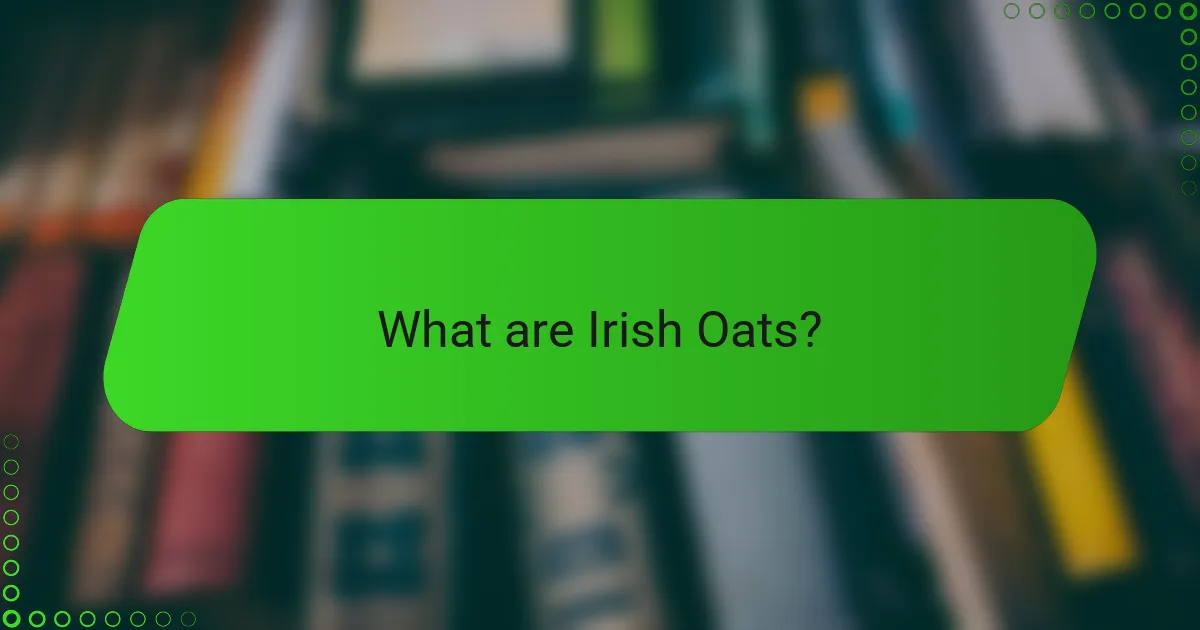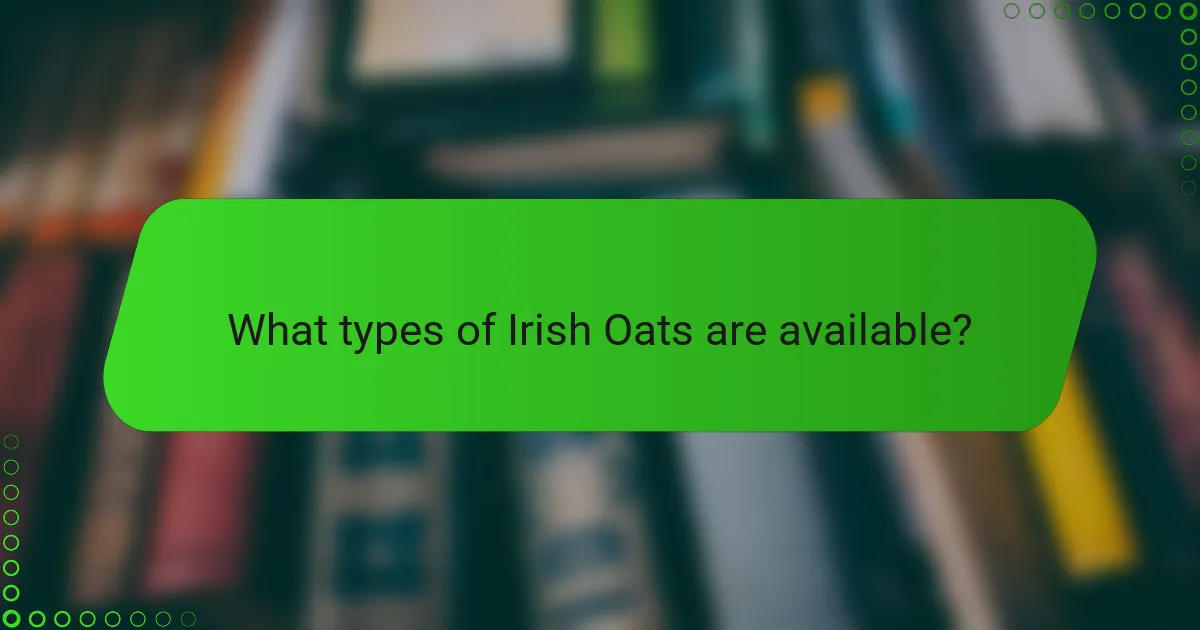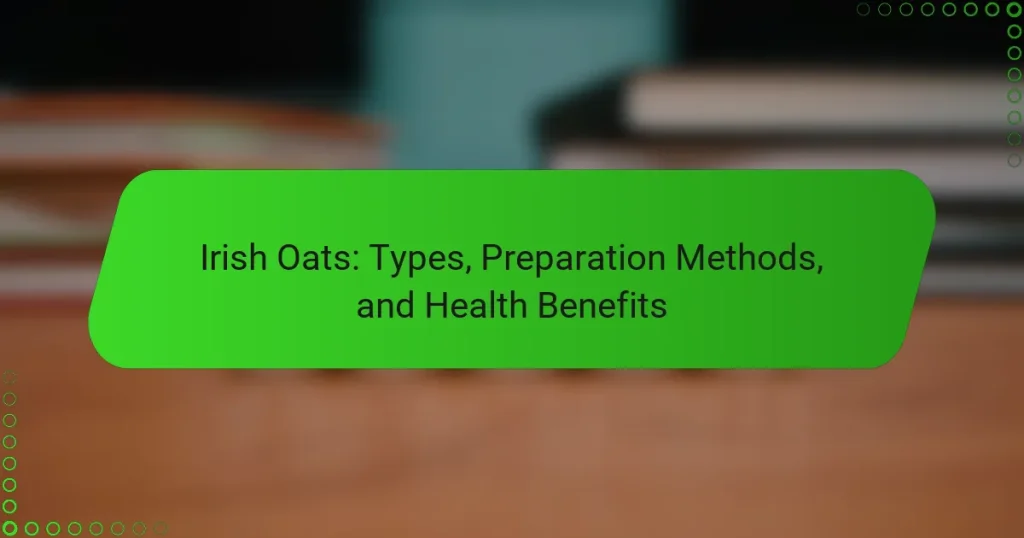Irish oats are whole grain oats cultivated and processed in Ireland, available in three primary types: steel-cut oats, rolled oats, and instant oats. Steel-cut oats are minimally processed, offering a chewy texture, while rolled oats are steamed and flattened for quicker cooking. Instant oats are pre-cooked, allowing for rapid preparation. Known for their rich flavor and high fiber content, Irish oats also provide essential vitamins and minerals, contributing to digestive health. Various preparation methods, including soaking, boiling, and baking, enhance their taste and texture while preserving nutritional benefits.

What are Irish Oats?
Irish oats are whole grain oats that are grown and processed in Ireland. They are typically steel-cut or rolled oats. Steel-cut oats are minimally processed and retain a chewy texture. Rolled oats are steamed and flattened, resulting in quicker cooking times. Irish oats are known for their rich flavor and nutritional benefits. They are high in fiber, which supports digestive health. Additionally, they contain essential vitamins and minerals, such as iron and magnesium. The unique growing conditions in Ireland contribute to their distinct taste and quality.
How do Irish Oats differ from other types of oats?
Irish oats differ from other types of oats primarily in their processing method. Irish oats are typically steel-cut, meaning they are whole oat groats that are chopped into pieces. This results in a chewier texture and a nuttier flavor compared to rolled or instant oats. Rolled oats are steamed and flattened, which leads to a quicker cooking time and a softer texture. Instant oats are pre-cooked and then dried, making them the fastest to prepare but often less nutritious. The steel-cut process used for Irish oats retains more of the grain’s natural fiber and nutrients. This processing method contributes to a lower glycemic index, making Irish oats a healthier option for sustained energy.
What unique attributes define Irish Oats?
Irish Oats are characterized by their unique growing conditions and traditional processing methods. They are typically grown in the cool, moist climate of Ireland. This environment contributes to their distinct flavor and texture. Irish Oats are often stone-ground, which preserves their nutritional content. They have a coarser texture compared to other oat varieties. This texture enhances their ability to absorb liquids during cooking. Additionally, Irish Oats are known for their high soluble fiber content, particularly beta-glucans. This fiber is linked to various health benefits, including improved heart health and digestion.
Why are Irish Oats considered a staple in Irish cuisine?
Irish oats are considered a staple in Irish cuisine due to their nutritional value and versatility. They are a rich source of fiber, protein, and essential vitamins. Historically, oats have been cultivated in Ireland for centuries. They thrive in the country’s cool, wet climate, making them a reliable crop. Traditional Irish porridge, made from oats, is a common breakfast dish. This dish provides warmth and sustenance, especially during colder months. Additionally, oats are used in various baked goods, such as soda bread and cookies. Their adaptability in cooking further cements their status in Irish culinary practices.
What are the nutritional benefits of Irish Oats?
Irish oats are highly nutritious and provide several health benefits. They are an excellent source of dietary fiber, which aids digestion and helps regulate blood sugar levels. A typical serving contains about 4 grams of fiber. Irish oats are also rich in protein, offering approximately 6 grams per serving. This protein content supports muscle health and satiety.
Additionally, they are a good source of essential vitamins and minerals. Irish oats contain B vitamins, particularly thiamine and folate, which are important for energy metabolism. They also provide minerals like iron and magnesium, contributing to overall health.
Moreover, Irish oats are known for their beta-glucan content, a type of soluble fiber that can lower cholesterol levels. Studies show that regular consumption can reduce LDL cholesterol by 5-10%. Overall, the nutritional profile of Irish oats makes them a beneficial addition to a balanced diet.
How do Irish Oats contribute to overall health?
Irish oats contribute to overall health by providing essential nutrients and promoting various health benefits. They are high in dietary fiber, which aids digestion and helps maintain a healthy weight. The soluble fiber in Irish oats can lower cholesterol levels, reducing the risk of heart disease. Additionally, they contain important vitamins and minerals, including manganese, phosphorus, and magnesium. These nutrients support bone health and metabolic functions. Research shows that consuming oats regularly can improve blood sugar control, making them beneficial for individuals with diabetes. Overall, incorporating Irish oats into the diet supports cardiovascular health, weight management, and stable energy levels throughout the day.
What vitamins and minerals are abundant in Irish Oats?
Irish oats are abundant in several vitamins and minerals. They are particularly rich in manganese, phosphorus, magnesium, and iron. Manganese is essential for bone formation and metabolism. Phosphorus contributes to energy production and bone health. Magnesium supports muscle and nerve function. Iron is crucial for oxygen transport in the blood. Additionally, Irish oats provide B vitamins, including thiamine and folate, which are important for energy metabolism and cell function. These nutrients make Irish oats a nutritious choice for a balanced diet.

What types of Irish Oats are available?
Irish oats are primarily available in three types: steel-cut oats, rolled oats, and instant oats. Steel-cut oats are whole oat groats that have been chopped into pieces. They have a chewy texture and take longer to cook. Rolled oats are steamed and then flattened with large rollers. They cook faster and have a softer texture. Instant oats are pre-cooked and dried, allowing for quick preparation. Each type offers different cooking times and textures, catering to various preferences and meal options.
What are the various forms of Irish Oats?
Irish oats are available in several forms. The most common forms include steel-cut oats, rolled oats, and instant oats. Steel-cut oats are whole oat groats that have been chopped into pieces. They have a chewy texture and take longer to cook. Rolled oats are steamed and then flattened with large rollers. They cook faster than steel-cut oats and have a softer texture. Instant oats are pre-cooked and then dried. They are the quickest to prepare, requiring only hot water or a microwave. Each form retains the nutritional benefits of oats, including high fiber content and essential vitamins.
How do steel-cut oats compare to rolled oats?
Steel-cut oats differ from rolled oats in texture and cooking time. Steel-cut oats are whole oat groats that are chopped into pieces. They have a chewy texture and a nutty flavor. Cooking steel-cut oats typically takes 20 to 30 minutes. In contrast, rolled oats are steamed and flattened, resulting in a softer texture. Rolled oats cook faster, usually in about 5 to 10 minutes. Nutritionally, both types provide fiber and essential nutrients. However, steel-cut oats generally have a lower glycemic index, which may offer better blood sugar control.
What is the processing method for each type of Irish Oats?
Irish oats are processed into three main types: steel-cut, rolled, and instant. Steel-cut oats are whole oat groats that are chopped into pieces. This method retains the most texture and flavor. Rolled oats are steamed and then flattened with large rollers. This process helps them cook faster while still maintaining some chewiness. Instant oats are pre-cooked and then dried. This results in a quick-cooking product that has a softer texture. Each processing method affects the cooking time and texture of the oats.
What are the cooking times and textures of different types of Irish Oats?
Irish oats come in three main types: steel-cut, rolled, and instant. Steel-cut oats have a cooking time of 20-30 minutes. They yield a chewy texture and nutty flavor. Rolled oats cook in 5-10 minutes. They produce a creamier texture and are more tender. Instant oats require only 1-2 minutes to prepare. They have a soft texture but can be mushy. Each type of oat offers a distinct cooking time and texture, making them suitable for different recipes and preferences.
How does the cooking method affect the texture of Irish Oats?
The cooking method significantly affects the texture of Irish oats. Different methods yield varying degrees of creaminess and chewiness. For instance, boiling oats in water or milk results in a softer, creamier texture. In contrast, soaking oats overnight and then cooking them leads to a chewier consistency. Cooking time also plays a crucial role; longer cooking results in a softer texture, while shorter cooking times retain more bite. The addition of fats, such as butter, can enhance creaminess. Overall, the chosen cooking method directly influences the final texture of the oats.
What are the recommended cooking times for each type?
Irish oats include steel-cut, rolled, and instant varieties. Steel-cut oats typically require 20 to 30 minutes of cooking. Rolled oats take about 5 to 10 minutes to cook. Instant oats only need 1 to 2 minutes of cooking time. These times ensure optimal texture and flavor for each type. Cooking times may vary slightly based on specific brands and personal preferences.

What are the preparation methods for Irish Oats?
Irish oats can be prepared using several methods. Common methods include soaking, boiling, and baking. Soaking involves letting the oats sit in water or milk overnight. This method softens the oats and reduces cooking time. Boiling is done by adding oats to boiling water or milk and cooking until desired consistency is reached. This method typically takes around 10 to 20 minutes. Baking can be done by mixing oats with other ingredients and placing them in the oven. This method creates a baked dish like oatmeal cookies or oat bars. Each preparation method enhances the flavor and texture of the oats while maintaining their nutritional benefits.
How can Irish Oats be prepared for meals?
Irish oats can be prepared for meals by cooking them in various ways. The most common method is to boil them in water or milk. Typically, a ratio of 1 part oats to 2 parts liquid is used. Cooking time can vary; rolled oats usually take about 5 to 10 minutes, while steel-cut oats require 20 to 30 minutes.
Another preparation method is to soak the oats overnight. This can reduce cooking time and enhance digestibility. Oats can also be used in baking, such as in oatmeal cookies or bread. They can be blended into smoothies for added nutrition.
Additionally, oats can be cooked with spices and fruits for flavor. Popular additions include cinnamon, apples, or berries. This versatility makes Irish oats suitable for breakfast, snacks, or even desserts.
What are traditional recipes for cooking Irish Oats?
Traditional recipes for cooking Irish oats include porridge, overnight oats, and oatcakes. Porridge is made by simmering the oats in water or milk until creamy. Typically, it is cooked for about 10-15 minutes. Overnight oats involve soaking the oats in milk or yogurt overnight for a quick breakfast. Oatcakes are made by mixing oats with water and baking them until crisp. These recipes reflect traditional Irish methods, emphasizing simplicity and wholesome ingredients. Oats have been a staple in Irish cuisine for centuries, known for their nutritional benefits.
How can Irish Oats be incorporated into modern dishes?
Irish oats can be incorporated into modern dishes in various ways. They serve as a nutritious base for breakfast bowls. Adding fruits, nuts, and honey enhances their flavor and texture. Irish oats can also be used in smoothies for added creaminess and fiber. They work well in baked goods, such as cookies and muffins, providing a hearty texture. Additionally, they can be used as a thickener in soups and stews. Incorporating Irish oats into granola or energy bars boosts nutritional content. Their versatility allows for savory dishes, such as oat risotto or savory oat pancakes. Overall, Irish oats are adaptable to numerous contemporary culinary applications.
What are some tips for enhancing the flavor of Irish Oats?
To enhance the flavor of Irish oats, consider adding spices like cinnamon or nutmeg. These spices can provide warmth and depth to the dish. Incorporating a pinch of salt can also bring out the natural sweetness of the oats.
Using milk or a dairy alternative instead of water during cooking adds creaminess and richness. Sweeteners such as honey, maple syrup, or brown sugar can enhance the overall taste.
Fresh fruits like berries or bananas contribute natural sweetness and texture. Nuts and seeds can add crunch and healthy fats, improving flavor and nutrition.
Lastly, a splash of vanilla extract can elevate the flavor profile significantly. Each of these tips can transform plain Irish oats into a delicious meal.
What ingredients pair well with Irish Oats?
Ingredients that pair well with Irish oats include fruits, nuts, and dairy. Fresh fruits like bananas, berries, and apples add natural sweetness and flavor. Nuts such as almonds, walnuts, and pecans provide healthy fats and crunch. Dairy options like milk or yogurt enhance creaminess and nutritional value. Spices like cinnamon and vanilla can elevate the taste profile. Additionally, sweeteners such as honey or maple syrup complement the oats’ flavor. These pairings create a balanced and nutritious meal.
How can spices and toppings elevate the dish?
Spices and toppings can significantly elevate a dish by enhancing its flavor profile. They introduce complex tastes that can transform the overall experience of the meal. For example, cinnamon adds warmth and sweetness to Irish oats, while nutmeg provides a hint of earthiness. Additionally, toppings like fresh fruits or nuts contribute texture and nutritional benefits. Studies show that spices can also have health benefits, such as anti-inflammatory properties. Incorporating these elements can make a dish more appealing and satisfying, promoting a balanced diet.
What practical tips can help in cooking Irish Oats effectively?
To cook Irish oats effectively, use a ratio of 1 part oats to 4 parts water or milk. This ensures optimal creaminess and texture. Bring the liquid to a boil before adding the oats. Stir the mixture to prevent clumping. Reduce the heat to low and simmer for about 20-30 minutes. Stir occasionally to achieve a creamy consistency. Let the oats sit for a few minutes after cooking to thicken. For added flavor, consider incorporating salt or sweeteners during cooking. The nutritional value of Irish oats includes high fiber content, which supports digestion.
Irish oats are whole grain oats grown and processed in Ireland, primarily available as steel-cut or rolled oats. This article covers the unique attributes of Irish oats, their processing methods, and the differences between types, including their nutritional benefits such as high fiber content and essential vitamins. It also explores various preparation methods, traditional recipes, and modern culinary applications, highlighting how to enhance their flavor with spices and toppings. Overall, Irish oats are a versatile and nutritious staple in both Irish cuisine and contemporary diets.


